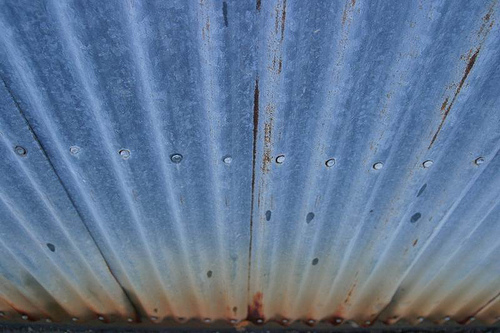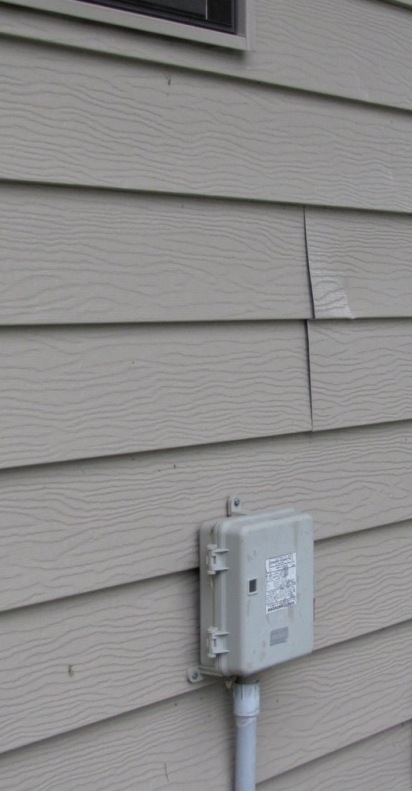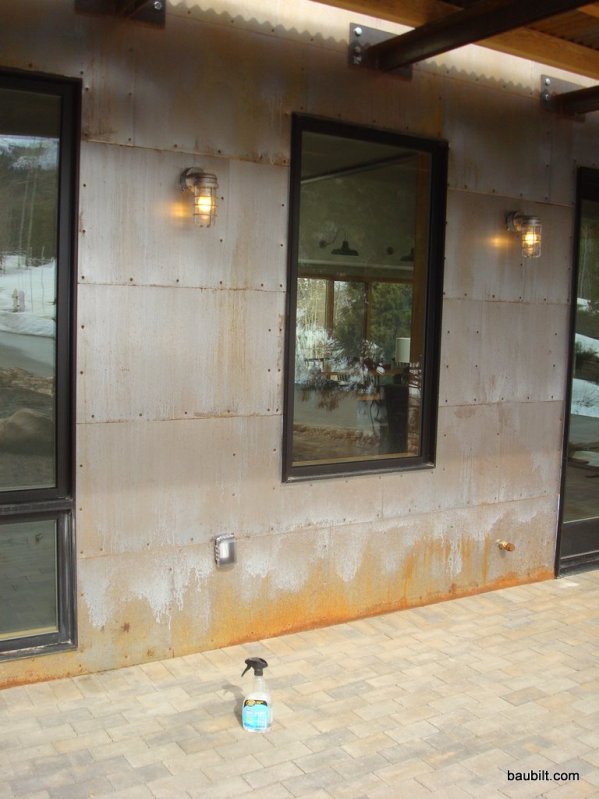Steel Siding Inspection
by Nick Gromicko, CMI® and Kate Tarasenko

Sheet iron and steel clapboard siding were patented in 1903. Sears, Roebuck & Company began offering embossed steel siding in stone and brick patterns in the 1930s.
During this time, rural North America saw a shift in agricultural practices from animal-driven to equipment-dependent, necessitating a quick and economical method of constructing farm outbuildings to house machinery and supplies. One popular result was structures known as pole barns, which used debarked, de-limbed sections of tree trunks to support the outer walls and roof, which were composed of galvanized, corrugated or grooved sheet steel siding. The buildings proved extremely durable, as they still dot the rural American landscape today. Barn designs have since evolved based on aesthetics and available resources, but most of them still incorporate steel as a siding material, and many modern barns are constructed almost entirely from steel.
The Properties of Steel Siding
Modern steel siding may be made from galvanized steel or stainless steel – a distinction that influences its vulnerability to rust. Galvanized steel is coated with a thin layer of corrosion-resistant zinc that may eventually wear away due to rust caused by moisture that may penetrate through a deep scratch caused by environmental impact or mechanical damage. The chromium in stainless steel serves the same purpose as the zinc on galvanized steel, except that the chromium is mixed throughout the steel. As a result, the chromium cannot be worn away, which makes stainless steel comparatively more corrosion-resistant than galvanized steel.
Homeowners can also choose between the following steel alternatives:
- Seamless steel encompasses a variety of steel siding which is cut to the exact length of a building, thereby eliminating unsightly seams that allow for moisture penetration and strong winds to dislodge individual panels. Seamless steel contributes to a tighter building envelope, which lowers energy bills and reduces greenhouse gases.
- Steel log siding replicates the rustic appearance of a log cabin without any seams or vulnerability to rodents, decay or the other problems inherent in log homes (some of which are explained in InterNACHI’s article on Inspecting Log Homes).
- For additional strength and rigidity, builders often use corrugated steel siding, which comes in a variety of profiles, from large-scale “barn roof” sizes that provide dramatic light and shadow, to smaller profiles used in decking. Corrugated steel is more difficult to clean, however, and attaching signs and other objects can be difficult.
- strength and durability. Steel can better withstand impact from baseballs and tree branches than weaker siding materials, such as vinyl, wood, brick and aluminum. In areas prone to severe weather, steel is desirable for its resistance to large hailstones, windblown debris, and bitter cold. Also, steel siding will not become brittle with age;
- little required maintenance. Steel siding requires comparatively little maintenance because most accumulated dirt and debris is washed away by rain. A garden hose can also be used, and steel is strong enough to withstand the force of a pressure-washer when extra strength is required;
- insect- and decay-resistance. Metal siding is inorganic and resistant to decay. Insects and rodents are not attracted to steel and they cannot penetrate it;
- fire-resistance. Steel siding will not catch fire or burn, and, under ordinary circumstances, it will not melt. Steel’s melting point is approximately 2,500° F (1,370° C), making it unlikely to melt in a house fire, while aluminum’s melting point of 1,220° F (660° C) means that it will succumb in a fire. So, if the barbecue gets too close to the house’s steel siding, for instance, the occupants will probably be safe; and
- color retention. Steel will not fade, unlike aluminum siding, which fades over time and acquires a chalky texture from the effects of weathering.
- corrosion (rust) caused by prolonged exposure to moisture.
 Rust is an issue that is unique to steel and iron, and it can be a serious nuisance in coastal and humid regions. Look for a red, orange or brown pitting or scaling, which will allow for the intrusion of moisture, insects or debris into the building. Refer to InterNACHI’s article on Rust Inspection and Prevention for more information regarding rust treatment and prevention;
Rust is an issue that is unique to steel and iron, and it can be a serious nuisance in coastal and humid regions. Look for a red, orange or brown pitting or scaling, which will allow for the intrusion of moisture, insects or debris into the building. Refer to InterNACHI’s article on Rust Inspection and Prevention for more information regarding rust treatment and prevention; - expense. Steel siding generally has a higher upfront cost than aluminum and other siding options. It lasts longer than siding alternatives, however, so its use may be cost-effective in the long run. Manufacturers claim that steel siding will last the lifetime of a house, and some even offer warranties of 50 years or more, while aluminum and vinyl will require costly replacement. The home’s resale value, however, may be reduced if buyers are wary of purchasing a building with an uncommon siding type;
- difficult installation. Steel is heavier than aluminum and installation is more labor-intensive. A special and expensive blade must be used to cut steel, and the process is very noisy, which may bother neighbors if the steel needs to be cut on site. Steel siding installation is rarely a DIY project; it requires an experienced installer. Repair of a damaged segment requires replacement of an entire metal sheet, which is far more difficult and expensive than replacing a single piece of vinyl; and
- energy-inefficient. Compared with non-metal sidings, steel easily transfers heat between the living area and the exterior, which will elevate energy costs and indoor temperature regulation. An energy-efficient design using steel siding requires the installation of an insulating material beneath the steel. Steel is also a non-renewable resource and it requires a comparatively large amount of energy to manufacture.
Inspection Tips
InterNACHI inspectors can be on the lookout for the following defects in steel s iding:
iding:
- buckled or wavy surface or appearance. Thermal expansion and contraction can cause buckling if the steel is secured too tightly. Buckling can also occur where a light fixture is installed through the wall. The gaps created will allow moisture and pests to enter the building;
- loose panels. Where the siding is elevated from the building’s surface, check to make sure it’s securely attached to the building and to its adjacent panel. Strong winds can enlarge the fastening holes on seamless steel siding and cause it to come loose. The loose panels may also make loud noises in the wind;
- lack of grounding. Some jurisdictions require steel siding to be grounded to provide a safe route for electricity when a live wire or lightning strikes the building. The siding may be grounded to the grounded neutral service conductor, a grounding rod, or the building’s water piping. For more information on electrical grounding, refer to InterNACHI’s article on Grounding Electrodes;
- corrosion. Appearing as dark, rough spots, rust is unsightly and can weaken steel siding and allow the unwanted entry of moisture and pests. A layer of paint is adequate to prevent rusting, but paint eventually peels off, leaving the steel exposed. Inspect for rust where scratches, dents and other mechanical damage has removed paint or where improper installation has left the edges exposed to the weather. Rust is common in steel-sided barns and outhouses that are infrequently monitored. Salty seawater can quickly corrode steel, which makes alum
 inum more appropriate for buildings in coastal areas; and
inum more appropriate for buildings in coastal areas; and - dents and scratches. Steel siding can be dented by strong forces, such as large hail, stacked firewood or falling tree branches. Steel can also be scratched fairly easily, exposing the area to the hazards of unsightly rust.
If the siding needs a new coat of paint, first scrape off all debris, caulk or rust from the surface and spot-clean any stains with a scrub brush using vinegar and water. Avoid the use of corrosive cleaners. Then, apply a coat of rust-retardant metal primer intended for steel siding before applying a coat of acrylic house paint over the metal primer and allow it to dry.
InterNACHI inspectors uncertain of a building’s siding type can use a magnet to identify steel, as no other popular siding type is magnetic. The presence of rust also indicates that it’s steel.

